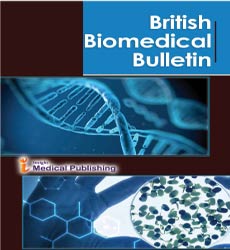ISSN : 2347-5447
British Biomedical Bulletin
Cell-Free Synthetic Biology: Important Domain of Application-Based Synthetic Biology
Yenan Bryceson*
Department of Medicine, Karolinska University Hospital, Stockholm, Sweden
- *Corresponding Author:
- Yenan Bryceson
Department of Medicine, Karolinska University Hospital, Stockholm, Sweden
E-mail:Yenanbryce556@yahoo.com
Received date: : July 05, 2022, Manuscript No. IPBBB-22-14497; Editor assigned date: : July 07, 2022, PreQC No. IPBBB-22-14497(PQ); Reviewed date:July 20, 2022, QC No IPBBB-22-14497; Revised date:: : July 26, 2022, Manuscript No. IPBBB-22-14497 (R); Published date:Aug 08, 2022, DOI: 10.36648/2347-5447.10.4.3
Citation: Bryceson Y (2022) Cell-Free Synthetic Biology: Important Domain of Application-Based Synthetic Biology. Br Biomed Bull Vol. 10 Iss No.4:003.
Description
The field of cell-free synthetic biology has undergone tremendous growth in the past few years and is on track to become an important domain of application-based synthetic biology. This builds on years of pioneering efforts by many such as, Swartz, Ueda, Noireaux and Jewett, who established the fundamental “operating systems” for a diverse range of proof-of-concept applications. As part of this applied effort, during my postdoctoral studies with Jim Collins, we showed that cell-free systems can be freeze-dried and hosted in porous matrices such as paper. This, along with the work of others, has introduced the exciting possibility of deploying poised synthetic gene networks outside of the laboratory in a bio safe mode. These Freeze-Dried Cell-Free (FD-CF) reactions also have the important advantage of allowing for distribution and storage at room temperature, and thus avoid the need for a cold chain. In the time since these ideas were first reported, work from us and from across the community has extended this concept to other exciting applications, and there is a growing interest in using FD-CF reactions for the delivery of synthetic biology and biotechnology to new environments.
De-Centralized Diagnostics and the Portable Manufacturing of Protein-Based Therapeutics
From my perspective, what makes FD-CF a system so compelling is their potential to extend access to healthcare through the development of freeze-dried platforms for de-centralized diagnostics and the portable manufacturing of protein-based therapeutics? A similar case could be made for many other applications where portable sensing and manufacturing could enhance real world capabilities (e.g. agriculture, national security). Research in general stands to benefit greatly from the potential for FD-CF to enable rapid prototyping of genetic constructs and to make on-demand, small-batch custom molecular reagents broadly accessible. Below, I will highlight a subset of the most exciting work to date in cell-free synthetic biology and will consider how this new portable format can extend the reach of biotechnology to more diverse and mainstream applications. During these early days, as the field is still emerging, it is the collective effort of the community that will advance the field through the remaining technical challenges to practical implementation. However, given the nature of perspective articles, this is not an exhaustive review and so I apologize in advance to those whose work is not referenced.
Experience in Building Whole-Cell Biosensors
In most cases, these sensor demonstrations come from research groups that also have considerable experience in building whole-cell biosensors, and this highlights an important feature of cell-free synthetic biology in general. While not always portable between systems, many synthetic biology applications are compatible with either environment. This potential for tool sharing is good news for both cell-free and cell-based communities and will hopefully lead to more practical implementation of technologies on both sides. Interestingly, similar efforts have aimed to bring greater portability to cell-based tools. An example of such work has been demonstrated by the Daunert lab; here, E.Coli-hosted sensors for the quorum molecule AHL were dried onto paper strips. Upon rehydration, cells responded to the presence of target molecules with the production of LacZ and a corresponding colorimetric response. As population growth continues, issues like food and health security are becoming important challenges for the world. The umbrella of biotechnology, which includes synthetic biology, offers to bring the weight of fundamental biology, chemistry and engineering to bear on these problems. While cell-based solutions will certainly play a key role, de-centralized modes of delivering these benefits will ensure distributed capabilities and greater access. With this aspiration in mind, it will be essential for us to venture beyond the bench and test our FD-CF sensors and manufacturing platforms directly in the field and with patients. Such efforts will not only improve our science, but will also make sure that the benefits of our work are realized.
Open Access Journals
- Aquaculture & Veterinary Science
- Chemistry & Chemical Sciences
- Clinical Sciences
- Engineering
- General Science
- Genetics & Molecular Biology
- Health Care & Nursing
- Immunology & Microbiology
- Materials Science
- Mathematics & Physics
- Medical Sciences
- Neurology & Psychiatry
- Oncology & Cancer Science
- Pharmaceutical Sciences
